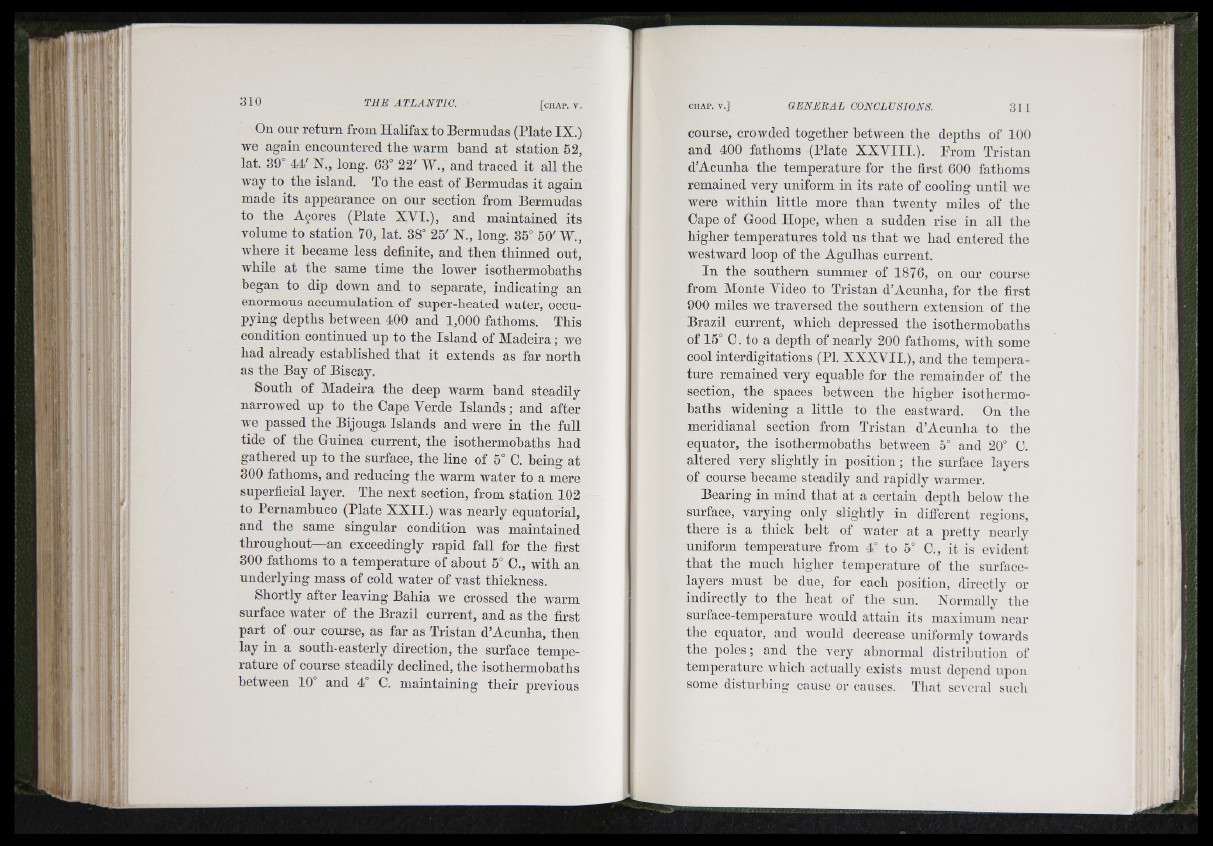
M» ■ i ; | i l - !I 1. [; I ,i; j
I
i!
On onr return from Halifax to Bermudas (Plate IX.)
we again encountered the warm hand at station 52,
lat. 39° 4P N., long. 63° 22' W., and traced it all the
way to the island. To the east of Bermudas it again
made its appearance on onr section from Bermudas
to the Açores (Plate XVI.), and maintained its
volume to station 70, lat. 38° 25' N., long. 35° 50' W.,
where it became less definite, and then thinned ont,
while at the same time the lower isothermohaths
began to dip down and to separate, indicating an
enormous accumulation of super-heated water, occupying
depths between 400 and 1,000 fathoms. This
condition continued up to the Island of Madeira ; we
had already established that it extends as far north
as the Bay of Biscay.
South of Madeira the deep warm band steadily
narrowed up to the Cape Verde Islands ; and after
we passed the Bijouga Islands and were in the full
tide of the Guinea current, the isothermohaths had
gathered up to the surface, the line of 5° 0. heing at
300 fathoms, and reducing the warm water to a mere
superficial layer. The next section, from station 102
to Pernambuco (Plate XXII.) was nearly equatorial,
and the same singular condition was maintained
throughout—an exceedingly rapid fall for the first
300 fathoms to a temperature of ahout 5° C., with an
underlying mass of cold water of vast thickness.
Shortly after leaving Bahia we crossed the warm
surface water of the Brazil current, and as the first
part of our course, as far as Tristan d’Acunha, then
lay in a south-easterly direction, the surface temperature
of course steadily declined, the isothermohaths
between 10° and 4° C. maintaining their previous
course, crowded together between the depths of 100
and 400 fathoms (Plate XXVIII.). Ifrom Tristan
d’Acunha the temperature for tbe first 600 fatlioms
remained very uniform in its rate of cooling until we
were within little more tban twenty miles of the
Cape of Good Hope, when a sudden rise in all tbe
higher temperatures told ns that Ave had entered the
westward loop of the Agulhas current.
In the southern summer of 1876, on our course
from Monte Video to Tristan d’Acnnha, for the first
900 miles Ave traversed the southern extension of the
Brazil current, which depressed the isothermohaths
of 15° 0 . to a depth of nearly 200 fathoms, with some
cool interdigitations (PI. XXXVII.), and the temperature
remained very equable for the remainder of the
section, the spaces between tbe higher isothermohaths
widening a little to the eastward. On tlie
meridianal section from Tristan d’Acunha to the
equator, the isothermohaths between 5° and 20° C.
altered very slightly in position ; the surface layers
of course became steadily and rapidly Avarmer.
Bearing in mind th a t at a certain depth beloAV the
surface, varying only slightly in diflferent regions,
there is a thick belt of water at a pretty nearly
uniform temperature from 4° to 5° C., it is evident
th a t the mnch higher temperature of the surface-
layers must be due, for each position, directly or
indirectly to the heat of the sun. Normally the
surface-temperature AA Ould attain its maximum near
the equator, and would decrease uniformly toAvards
the poles ; and the very abnormal distribution of
temperature Avbicb actually exists must depend upon
some disturbing cause or causes. Tbat several sucb